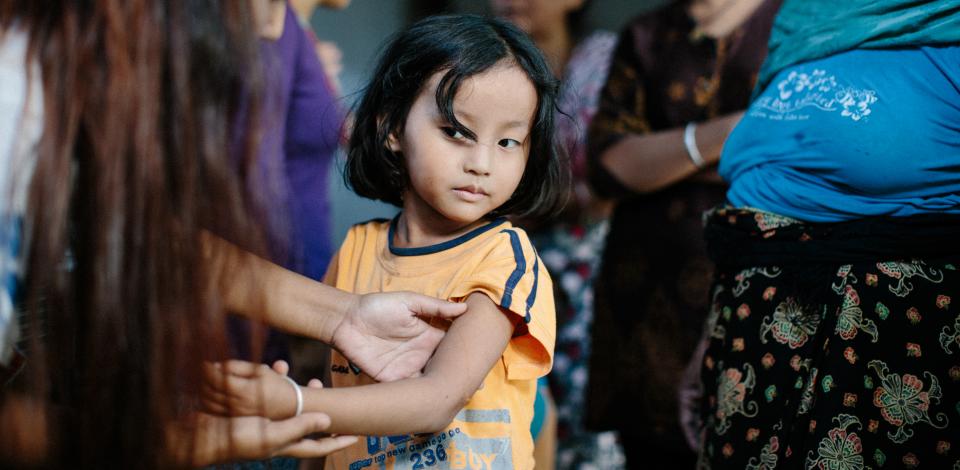
Inclusion as a basic right and factor for success
Persons affected by NTDs or other health conditions have the right to be, and should be, actively involved in decision-making processes regarding policies and programmes that directly concern their lives. Besides being their right, including them is also essential for the success of an intervention that will affect them. They have inside knowledge and expertise in the problem that is to be tackled. An intervention cannot be designed and monitored optimally without this expertise.
Exercise 3: Involving affected persons in the design
This is a long exercise that can take some time. It makes participants think critically about interventions. The objective is to support participants to go through some steps of a project design phase. See Guide 3 Annex 1: Training exercises and tips for further details.
Levels of participation
Participation of the target group in the planning and monitoring of an intervention is a well-known practice in the development sector. Client participation is also gaining ground in the health sector. For client participation projects initiated by the health services, the question of who feels responsible for the project after the implementers have withdrawn may remain. Will the positive results be sustained or will the initiative collapse? For projects where affected persons are the ones planning and implementing the intervention, there is full ownership and engagement of persons affected. This is the most ideal situation, because when people feel ownership for something, you can expect that they will stay engaged and will want to sustain the successful results that are achieved.
Realistically, participation in all aspects of decision-making and implementation of an intervention is not always possible. But the basic principle remains that persons affected should be involved in decision-making processes for policies and programmes that affect their lives. Sometimes this may need extra effort, such as translation to a local language during meetings or providing training on certain skills to make meaningful participation possible.
There are many levels of participation. At the lowest level, there are interventions in which the target groups are not consulted at all. As a consequence, the intervention design may miss essential information on the problem and situation of the target group. The intervention may then not have the results that were envisaged. At the next participation level, there is a passive consultation of the affected persons, for example by doing a rapid appraisal of their needs. Other people will then assess these needs and design a project for the target group. In some instances, transportation, lodging, food and/or per diem and other things need to be considered for participation to be equitable. Provisions should be made in the design of the intervention to support this.
Essentials of Participatory Learning and Action (PLA)
Common principles of PLA:
-
The focus should be on communal learning by the stakeholders through a system of joint analysis and interaction.
-
Different perspectives are encouraged and recorded: equal importance is given to the various ways people understand the realities of their lives and the range of solutions that different stakeholders use. This complexity of the world can only be revealed through group analysis and interaction.
-
Wherever possible, methods should be designed or adapted to the local situation, preferably with the involvement of all actors.
-
The role of outsiders (those who are not members of the community or group with whom they interact) is to guide local people in their decisions on what to do with information and the consequences of it. Outsiders may also choose to further analyse the findings generated by PLA so that they might influence policy-making processes at institutional or organisational levels. In either case, there should be commitment on the side of the facilitating organisations to do their best to assist or follow up on those actions that people have decided on as a result of PLA.
-
The process of joint analysis and dialogue helps to define changes that would bring about improvement and seeks to motivate people to take action to implement the defined changes.
Direct contact with affected persons
Programmes working with many different stigmatised diseases around the world have achieved good results when they facilitate direct contact between those holding negative attitudes or showing discriminatory behaviour and persons affected. The best results come from contact events, in which the target audience – such as health workers, service providers, or fellow community members – can meet and discuss with an affected person.
Providing information to a community, for example through posters depicting the causes or cure of a disease, helps people to gain knowledge. People may then know that they don’t need to be afraid of being infected by their neighbour. It has been proven, however, that knowledge alone does not necessarily change attitudes and behaviour. Being in contact, and having meaningful discussions, with persons who are affected by a health condition has the potential to greatly improve results. Hearing directly from an affected person about situations where he or she encounters stigma, or is discriminated against, helps people realise their own behaviour. This may more effectively compel them to change their behaviour than when they are only reading posters.
In practice, a combination of tools and methods will have the most effect on behaviour change. Direct contact with affected persons is most often an essential element of such an intervention. It has been shown that indirect contact, such as through video, can also be effective, especially if an opportunity for dialogue is created.

Empowerment and resilience
Involvement in an intervention is not only a basic right for affected persons, but also a condition for the intervention’s success. Being active in an intervention, having a role in decision-making and acting as a resource for knowledge and expertise can also greatly contribute to building self-confidence and resilience for the affected persons, which even just by itself can be a very valuable result of an intervention.
Please see the chapter on role models and champions in Guide 2: How to reduce the impact of stigma for additional explanation and approaches.
Champions
Champions are opinion leaders acting as role models for a cause. Champions in the context of NTDs are people who work on a voluntary basis as advocates for persons affected by NTDs and their families. Their main aim is to combat NTD-related stigma and discrimination and to improve the life chances of persons affected by NTDs. These champions serve as examples by positively influencing others, and they may become role models. NTD champions often have (or have had) an NTD themselves. Specific health staff or local leaders who are willing to step forward to further the cause can also be champions. Involving them in an intervention has many advantages.
Please see Guide 3 Annex 2: Creating a network of champions.
Leprosy is my strength, not my weakness
'I am Suresh Ramkrishna Dhondge, working as a Programme Manager with The Leprosy Mission Trust India. I developed leprosy in the year 1996 when I was studying in 10th grade. Due to irregular treatment I reached a point when I was totally bed-ridden. My father took me to Dr Bandorawalla Leprosy Hospital at Poona. By then I was unable even to walk. After two and half years of treatment I was referred to The Leprosy Mission’s VTC computer course. I had also restarted my education with the help of TLM and completed my three master’s degrees (MA, MBA, MSW). Presently I am directly working with 2000 people affected by leprosy and other disabilities for their holistic development.
In the year 2013 I got a National Award by the President of India in the category of Role Model—Leprosy Cured. Now I am a role model for people affected by leprosy and disability and my dream is ‘I want to be an example for believers through my faith, attitude and work.’

Informed consent
Any intervention directly targeting or involving affected persons will always have to require informed consent. This means that the person understands what kind of actions he or she is asked to be involved in, and what possible consequences this may have. He or she will have to agree to this before the intervention can take place. An obvious example is that if an intervention involves someone’s status being disclosed, the person should consent to it beforehand. They should also be aware of the consequences this may have for them personally and for their family. Without a person’s informed consent, his or her status cannot be disclosed.

 Infolep
Infolep